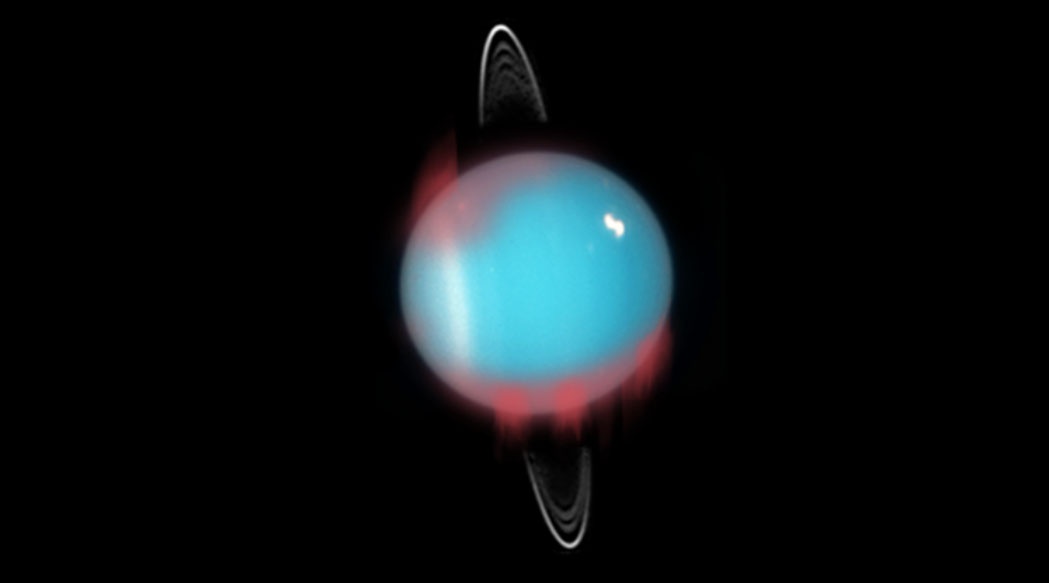Just in time for Hallowe’en, astronomers confirmed the existence of spooky-looking infrared auroras on Uranus. Their existence reveals something about that planet’s misaligned magnetic field.
Auroras happen when charged particles in the solar wind and near-planet environment get trapped by a planet’s magnetic field. They funnel down to the atmosphere and collide with gas molecules. This happens on Earth and we see auroras over the north and south poles of our planet. They also happen at other planets. Astronomers detect them on the other giant planets, and a smaller version of them occurs on Mars. Venus probably doesn’t experience similar types of auroral displays, since it has no intrinsic magnetic field. However, it may experience something like them during particularly gusty solar wind events. At the outer planets, the gas mix is different in the atmospheres. That means their aurorae show up in ultraviolet and infrared wavelengths.
Detecting the Infrared Auroras of Uranus
Uranus has an interesting magnetic field. It does not originate from the exact center of the planet. It’s also offset by 59 degrees from the rotation axis. That’s tipped 90 degrees from the plane of the solar system. This arrangement means that the Uranian magnetosphere is asymmetric and its field strengths vary depending on location. It connects with the solar wind once every Uranian day (which is 17 hours long). The planet does show some auroral activity, particularly around the poles and Hubble Space Telescope detected some in 2011.

The Uranus infrared aurorae showed up in observations made using the NIRSPEC spectrometer on the Keck II telescope on September 5, 2006. Astronomers from the University of Leicester analyzed the observations and zeroed in on wavelengths emitted by the H3+ charged particle. In the infrared spectrum, H3+ spectral lines will vary in brightness. Those variations depend on how hot or cold the particle is and how dense the layer of the atmosphere is where it exists. Essentially, H3+ lines can indicate something about the temperature of the atmospheric layer.
Interestingly, the Keck measurements showed that H3+ increases in density in the Uranian atmosphere. However, there’s not much change in temperature, which seems to be connected to the presence of the infrared auroras. Ph.D. student Emma Thomas, who led the observation team, p;ointed out that this may give a clue to the temperatures of the outer planets. “The temperature of all the gas giant planets, including Uranus, are hundreds of degrees Kelvin/Celsius above what models predict if only warmed by the Sun,” she said, “leaving us with the big question of how these planets are so much hotter than expected? One theory suggests the energetic aurora is the cause of this, which generates and pushes heat from the aurora down towards the magnetic equator.”
Implications of Uranian Auroras
The infrared auroras at Uranus may help planetary scientists understand something about similar-type planets around other stars, according to Thomas. “A majority of exoplanets discovered so far fall in the sub-Neptune category and hence are physically similar to Neptune and Uranus in size. This may also mean similar magnetic and atmospheric characteristics. By analyzing Uranus’s aurora which directly connects to both the planet’s magnetic field and atmosphere, we can make predictions about the atmospheres and magnetic fields of these worlds and hence their suitability for life,” she explained.

Another fascinating implication brings us right back to Earth. Periodically, our own planet’s geomagnetic pole locations flip. Scientists call that phenomenon “geomagnetic reversal.” Essentially, north flips to south and south flips to north. It’s a natural phenomenon but remains largely misunderstood. Thomas points out that there aren’t many studies of the flip. Such a flip could affect satellites, as well as communication and navigation systems. The Uranus results might provide a clue to any potential effects. “This process occurs every day at Uranus due to the unique misalignment of the rotational and magnetic axes,” she said. “Continued study of Uranus’s aurora will provide data on what we can expect when Earth exhibits a future pole reversal and what that will mean for its magnetic field.”
The team’s study of Uranian auroras is the latest in 30 years’ worth of Uranus observations, said Thomas. The infrared aurorae are the latest finding. “Our results will go on to broaden our knowledge of ice giant auroras and strengthen our understanding of planetary magnetic fields in our solar system, at exoplanets, and even our own planet,” she said.
For More Information
Uranus Aurora Discovery Offers Clues to Habitable Icy Worlds
Detection of the Infrared Aurora at Uranus with Keck-NIRSPEC

